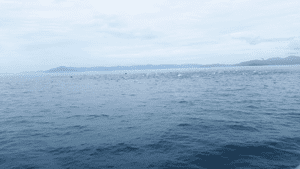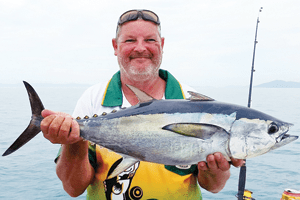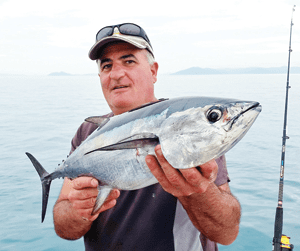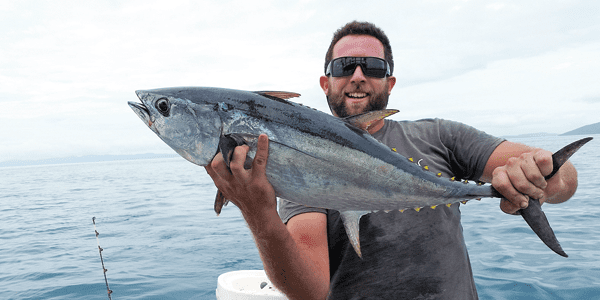When spotted, all efforts should be made to get close enough to let the fish see your lures and baits.
Don’t troll too close though because the larger fish usually patrol the edges of the schools.
Tuna breaching and smashing a bait ball is an awesome sight and really gets the blood pumping, making you absolutely want to hook one of the fish you can see feeding.
I don’t even want to think about a baitfish’s life; it must be full of fear and violence.
What a way to end… in the gullet of a predator, and alive in most cases. The schools of predators spend their lives in search of concentrations of these smaller fish, which is why when we present a piece of plastic, metal or wood they are (most of the time) ready to eat it.
When selecting lures, keep in mind what the predator is chasing. Mullet, squid, pilchards, slimy mackerel, garfish and wolf herring (ribbonfish) all have different colours and sizes. Matching your lures to these baits will produce better hit and hook-up rates.
Which lure will work best depends on what fish the area has to offer. When the predators are skittish or timid and trolling isn’t working, bring your lures in and set up a slug the size and colour of the baitfish present.
Try predicting their direction and stop in their path. Turn off the engine and cast your slug into the area in front of the school or near the edges of a bust-up. Casting straight into the school is a bit of a risk when the school is small and the fish are timid.
Sometimes it pays to let the slug fall through the water column to a depth of over 30m. Then with a fast retrieve, rip the lure back to the boat. If the fish are ‘sounding’ or diving regularly this method works well.



We recently went to Double Cone Island and found huge schools of longtail tuna, with some fish weighing over 15kg. The noise of these schools sounded like a waterfall and we laughed with excitement at the sound and spectacle.
Throwing small silver and chrome slugs at the bust-ups proved the only successful technique and we boated four fish in quick succession before the schools moved on. The tally for the four-hour trip was six good-sized longtail and a small chinaman fish we caught and released during a rest period.
Longtail tuna put on a good show on light tackle and test gear and rigs. Having good knots is important when hooked up to these speedsters. Get them right or do it again. Also sharpen your hooks, use a good leader and retrieve as fast as you can.
It is a good idea to have a small live fish swimming away from the boat when drifting near a school of predators. This baitfish will always be in with a chance of being taken by a fish patrolling the area and having a look at why there is so much noise.
Usually this fish is inhaled by the bigger versions of the predators smashing the bait ball.
Be aware that in some cases this live bait will be hit by a shark or other by-catch such as a mackerel or dolphin lurking in the area.
A few schools of mack, longtail and yellowfin tuna often hang in front of Hook Passage if you ever want to try any of these techniques. These fish get about in the cooler months and present an opportunity to try different options.
Deeper shoals can be found inside Whitsunday Island that produce good size table fish for those who can’t get out to the main passages between the bigger islands. Dropping squid or pilchards with sufficient weight to reach the bottom is the way to entice them.
Live baits are effectively unnecessary and will attract sharks. Plastics work but take some skill to manoeuvre around coral. Getting close but not too close is the trick and it takes considerable time to master knowing exactly where your lure is in relation to the coral.
Dragging the rubble bottoms in 30-40m is a great way to bring ‘reds’ (red emperor and nannygai) to the boat. Your bait or lure must be on the bottom to get the best fish. Successful trips have been enjoyed by the charter fishing boats heading to the other side of Hayman Island, where the nannygai are on and of a good size.
This time of year is always a challenge because the water is neither hot nor cold (relative to the area) and successfully targeting a particular species is a matter of finding out what other anglers have caught recently.
Keep an eye out for bust-ups and opportunities such as feeding birds when out on the water. And always stop in and have a chat to the guys at the local tackle shop. It will make a huge difference to your results!
 Bush ‘n Beach Fishing Magazine Location reports & tips for fishing, boating, camping, kayaking, 4WDing in Queensland and Northern NSW
Bush ‘n Beach Fishing Magazine Location reports & tips for fishing, boating, camping, kayaking, 4WDing in Queensland and Northern NSW









